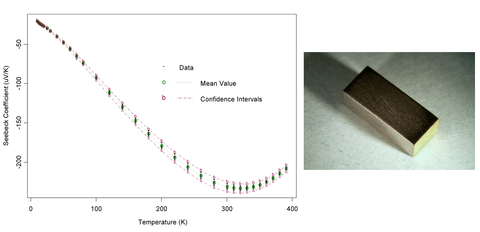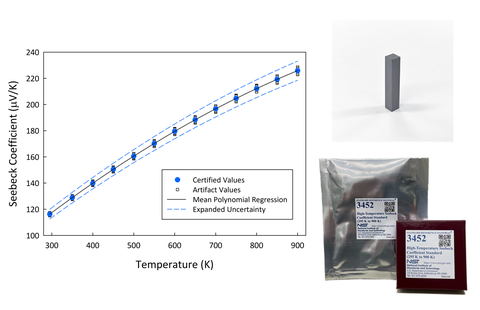Transport Property Standards
Seebeck coefficient
SRMs and validated measurement methods for transport properties will allow for interlaboratory validation of data, thereby accelerating the selection and optimization of materials and devices for commercialization. The Seebeck coefficient is a widely measured transport property that provides fundamental information on charge carrier transport and the electronic structure of materials, as it can be related to the reduced Fermi level, band gap, carrier concentration, effective mass, and carrier scattering mechanisms. More specifically, the Seebeck coefficient is an important predictor of thermoelectric performance (materials and devices that can convert heat into electricity). To provide the thermoelectric materials community the means to calibrate Seebeck coefficient measurement equipment for bulk materials, we certified and released for purchase in late 2011 SRM® 3451, “Low Temperature Seebeck Coefficient Standard (10 K to 390 K)”. Seebeck coefficient measurements are generally divided into the low (< 300 K) or the mid to high (> 300 K) temperature regime, due to different practical requirements in both instrumentation and sample contact methodology. SRM 3451 has been well received by the TE community throughout industry, national and federal research laboratories, and Universities, both domestic and foreign.

SRM® 3451, “Low-Temperature Seebeck Coefficient Standard (10 K to 390 K)"
To enable instrument validation and interlaboratory data comparison at high temperatures relevant to thermoelectric waste heat recovery, we have completed the development and certification of Standard Reference Material (SRM) 3452: High-Temperature Seebeck Coefficient Standard (295 K to 900 K), now available to the public. SRM 3452 is bar-shaped p-type boron-doped polycrystalline silicon-germanium alloy with a nominal composition of Si80Ge20. SRM 3452, together with complimentary SRM 3451, now provide certified reference materials traceable to the International System of Units for Seebeck coefficient measurements within the temperature range 10 K to 900 K with a broad overlap region (295 K to 390 K).

SRM® 3452, “High-Temperature Seebeck Coefficient Standard (295 K to 900 K)"
REFERENCES
J. Martin, Z.-Q. Lu, W. Wong-Ng, S. Krylyuk, D. Wang, and Z. Ren, Development of a High-Temperature (295 K to 900 K) Seebeck Coefficient Standard Reference Material, Journal of Materials Research 36(16), 3339-3352 (2021). DOI:10.1557/s43578-021-00362-8.
N. D. Lowhorn, W. Wong-Ng, Z.-Q. Lu, J. Martin, M. L. Green, J. E. Bonevich, E. L. Thomas, N. R. Dilley, and J. Sharp, Development of a Seebeck Coefficient Standard Reference Material, J. Mater. Res. 26, 1983 (2011).
Thermal conductivity
We are currently developing new reference materials for thermal conductivity that will enable instrument validation, the reliable interlaboratory comparison of data, and ultimately accelerate the commercialization of semiconducting materials and devices that rely on critical thermal property measurements. To this end, we have engaged a number of academic researchers, industry partners, and thermal measurement instrumentation manufacturers to identify specific measurement needs of the thermal community. Please contact joshua.martin [at] nist.gov (Joshua Martin) with any perspectives or questions.
TRANSPORT PROPERTY MEASUREMENTS FOR SEMICONDUCTORS AND ENERGY MATERIALS PROJECT
Contacts
-
(301) 975-3681

